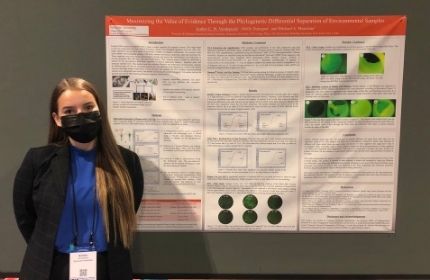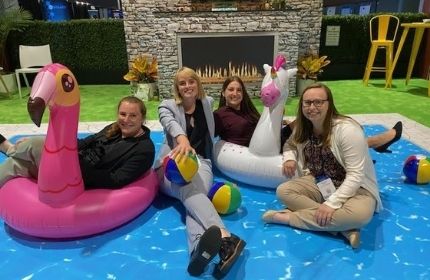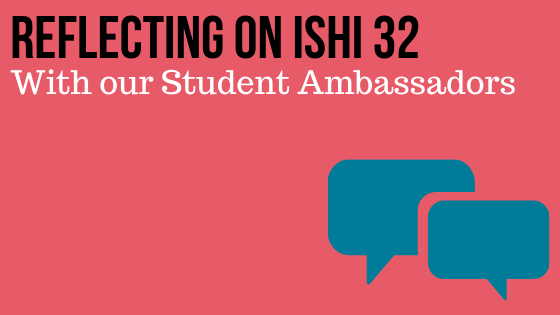We recognize that many students in forensic science have limited opportunities to attend conferences, including ISHI, and may not know what to expect as they hit the “Register Now” button. But, we also recognize that these students represent the next generation of Lab Directors, Tech Leaders, professors, and R&D scientists and they have a lot to teach all of us. This year, we were honored to bring four inspiring women to ISHI 32 in Orlando. In this interview, they reflect on their experience by sharing their biggest takeaways and provide advice for other students who are considering attending.
What were your first impressions of the conference?
Amber: I immediately noticed how well organized the conference was! The set-up of the different rooms made for a quick walk between the presentations and vendors. The online schedule was super easy to navigate and allowed me to make sure I did not miss any of the presentations or events I was interested in. Overall, it couldn’t have been a smoother experience and I enjoyed every minute of it!
Olivia: It was scary because I’d never been to Orlando before, so I had to take in new surroundings. It did help that I met up with the other student ambassadors the first night, so having other people my age that had never been to ISHI before was very nice.
Haley: I had a fantastic time at ISHI from the moment I got there! I was able to attend incredibly impactful and memorable presentations by leaders in the forensic DNA field, network with forensic professionals, and see first hand the incredible ongoing research in the field.
Nidhi: It was a very well-organized conference. I attended all the talks, workshops, went through poster presentations by my fellow peers, and network.
 |  |
How does ISHI compare to other meetings that you’ve been to?
Amber: ISHI was actually the first conference I have ever attended. I am extremely grateful that my first conference was such a well established and distinguished one.
Olivia: I have never been to another conference, but if the rest of them are like ISHI, then I’m excited to go to more!
Haley: By far and away, ISHI was the best meeting I’ve attended. Everyone was friendly and willing to answer questions about their professional experiences, the speakers were outstanding, and the location couldn’t have been better.
Nidhi: I was glad to attend a conference related to human identification which is closely related to my research. Also attending the conference in person was a bonus.
What was your favorite part of the conference?
Amber: My favorite part of the conference was stopping by all the vendor booths. I learned about many new technologies both in and outside of my discipline and had great conversations with many companies. When looking into some companies and products further, I found many webinars and resources that I am using to continue learning outside of the classroom.
Olivia: I really liked CeCe Moore’s presentation on the Starkville, Mississippi homicide case that she helped solve with Parabon. I live right next to Mississippi and have been to Starkville so I enjoyed listening about a case in a town that I was familiar with.
Haley: My favorite part of the conference was attending workshops. These smaller spaces allowed for a more comfortable environment to ask questions and meet new people.
Nidhi: I was fortunate to have been selected as an ISHI student ambassador. This gave me a great opportunity to present and talk about research. I also got the opportunity to interview Mark Desire, Assistant Director at Chief Medical Examiner’s Office. To sit and chat with him about his experience in the field was an invaluable experience. Special Thanks to the ISHI Organizing committee.
Did you make any new connections with attendees that will assist in your research?
Amber: I met Brian Young and Luigi Armogida from NicheVision in person for the first time! Together with NicheVision, Olivia D’Angelo, Dr. Michael Marciano, professor Jonathan Adelman, and I have been working on a project about motif specific stutter modeling. After having many phone calls with Brian and Luigi over the past year, it was great to finally put a face with the names.
Olivia: I’d like to think so. I met a lot of people from different DNA laboratories and a lot of different investigative genetic genealogists from different companies.
Haley: Yes! I asked a number of people for advice regarding my research objectives and was happy to receive some helpful feedback. I can’t wait to try some of their methods out!
Nidhi: I connected with people who work in the field of Forensic Genealogy and a few essential vendors who might help us better our research work with their experience and products.
 |  |
What is one thing that you learned while at the conference?
Amber: I definitely learned a lot at the conference through all the presentations I attended. I think I learned the most about Investigative Genetic Genealogy (IGG). This was a discipline I did not know much about and through the presentations I learned how it works and how it can be very effective in solving cold cases.
Olivia: The keynote presentation was about 9/11 and what they are doing to identify the still unidentified victims of the tragedy (roughly 40%). I learned a lot about how difficult those DNA extractions have been and how dedicated OCME is to return these remains to their families. I was only a few months old (born at the end of July 2001) when 9/11 occurred so I do not remember 9/11 when it occurred but I could sense the emotions from everyone in the room who were there or watched it on TV when it happened.
Haley: Networking is less intimidating that I thought it would be. The opportunity to speak with leading researchers and forensic practitioners will not only have an impact on my research, but it has also made me more excited to join the forensic DNA community!
Nidhi: I received good feedback through my poster presentation at the conference. I feel sharing your work with the forensic community and receiving their feedback was a great learning curve for me.
What are your biggest takeaways?
Amber: My biggest takeaway from the conference was to talk and have conversations with the professionals you meet. Everyone I spoke with, whether it was at my poster, at a booth, or even at Disney World, was extremely kind and willing to share their experiences and guidance with me. I am so grateful to have connected with so many scientists and professionals in the field and I hope to see them again at the next ISHI!
Olivia: I think I came out with a lot of new connections and friends. It certainly was memorable.
Haley: My biggest takeaway from ISHI is that forensic DNA research is the field I want to be in long-term, because I’ve never before attended a meeting in which everything I heard was what I wanted to do. I learned so much at ISHI (and had fun). I can’t wait to attend next year!
Nidhi: Learning about how the forensic community is working together to solve problems at hand with ongoing innovation and research was my biggest takeaway from the conference.
 |  |
Do you have any advice for other students or attendees considering attending ISHI?
Amber: My advice is to make the most out of the experience by attending as many events as you can! Attend every presentation and visit every booth even if you believe the topic doesn’t interest or apply to you. I truly learned the most from and was most fascinated by these presentations and vendors and can apply that knowledge to my current internship and my research.
Olivia: Network. Make connections. Put yourself out there.
Haley: Apply to be an ISHI Student Ambassador! It was so cool to meet other students with similar interests and have the opportunity to attend ISHI. I can’t recommend it enough!
Nidhi: Please do participate in the upcoming ISHI ambassador competition. It was an incredible experience. If you are planning to attend a conference related to forensic DNA analysis opt for ISHI.
Are you interested in becoming an ISHI ambassador? We will again be looking for students to represent ISHI in 2022. Stay tuned for more information, including important dates and how to apply in future issues of the magazine and on our social media channels.
Chosen applicants will be awarded free registration (including workshops) to the 33rd International Symposium on Human Identification.
This contest is open to students currently enrolled in a forensic science (or similarly named program) at the undergraduate or graduate levels. Applicants must have a public Facebook and Instagram profile to allow for sharing of content and will be asked to provide an original written essay and video recording with their submission.
Winners will be selected by a group of reviewers from the ISHI Committee. Those selected will be asked to provide:
- A 500-word blog post before the ISHI symposium
- A handful of social media posts before the symposium introducing themselves to the ISHI audience
- A scientific poster presentation at ISHI
- One Twitter post each day of the ISHI conference
- An on-site interview at the symposium with the ISHI media team
- A handful of photos taken at the event
- A 500-word blog post after the symposium about what was learned at the meeting
WOULD YOU LIKE TO SEE MORE ARTICLES LIKE THIS? SUBSCRIBE TO THE ISHI BLOG BELOW!
SUBSCRIBE NOW!


